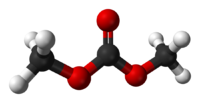- Dimethyl carbonate
-
Dimethyl carbonate 
 Dimethyl carbonateOther namesDMC
Dimethyl carbonateOther namesDMC
Methyl carbonate
Carbonic acid, dimethyl esterIdentifiers CAS number 616-38-6 
PubChem 12021 ChemSpider 11526 
ChEBI CHEBI:36596 
Jmol-3D images Image 1 - COC(=O)OC
Properties Molecular formula C3H6O3 Molar mass 90.08 g mol−1 Appearance Clear liquid Density 1.069-1.073 g/mL Melting point 2-4 °C, 275-277 K, 36-39 °F
Boiling point 90 °C, 363 K, 194 °F
Solubility in water 13.9 g/100 mL Hazards Main hazards Flammable  carbonate (verify) (what is:
carbonate (verify) (what is:  /
/ ?)
?)
Except where noted otherwise, data are given for materials in their standard state (at 25 °C, 100 kPa)Infobox references Dimethyl carbonate, often abbreviated DMC, a carbonate ester, is a flammable clear liquid boiling at 90 °C. This compound has found use as a methylating agent and more recently as a VOC exempt solvent in paints and adhesives (exempt in USA only). There is also interest in using this compound as a fuel oxygenate additive,[1]. It was classified as an exempt compound under the definition of volatile organic compounds by the U.S. EPA in 2009.[2]
Contents
Production
Dimethyl carbonate may be prepared by reaction of phosgene with methanol via methyl chloroformate:
- COCl2 + CH3OH → CH3OCOCl + HCl
- CH3OCOCl + CH3OH → CH3OCO2CH3 + HCl
Overall:
- COCl2 + 2 CH3OH → CH3OCO2CH3 + 2 HCl
This historical synthesis process is undesirable because of phosgene's toxicity and has been largely replaced by other synthesis routes. World production in 1997 was estimated at 1000 barrels a day.[1]
Dimethyl carbonate is currently produced industrially by a methanol ester interchange reaction using propylene carbonate and methanol as raw materials and forming dimethyl carbonate and propylene glycol. A second large scale commercial synthesis route uses a process where carbon monoxide, methanol and oxygen are reacted to form dimethyl carbonate and water.
Several new patents reference synthesis routes using methanol combined with carbon monoxide and/or carbon dioxide to produce dimethyl carbonate.
Reactions
Dimethyl carbonate's main benefit over other methylating reagents such as iodomethane and dimethyl sulfate is its much lower toxicity and its biodegradability.[3] Also, it is now prepared from catalytic oxidative carbonylation of methanol with carbon monoxide and oxygen, instead of from phosgene.[3] This allows dimethyl carbonate to be considered a green reagent.
Dimethyl carbonate is able to methylate anilines, phenols and carboxylic acids, but many of these reactions require the use of an autoclave.[4] One alternative involves the use of DBU, which allows methylation of phenols, indoles, and benzimidazoles[5] and the preparation of methyl carboxylate esters:[4]
Production
Due to its classification as a "green solvent" and being declared VOC exempt in 2009 by the EPA,{6} dimethyl carbonate has grown in popularity and applications exponentially in the past five years being used as a suitable replacement for methyl ethyl ketone, tert-butyl acetate, and parachlorobenzotrifluoride in many different product lines both lowering the VOCs as well as the cost as it is half the price as most of these products.
Production of dimethyl carbonate worldwide is limited strictly to Asia and Europe as there are no domestic U.S. manufacturers of dimethyl carbonate. Market growth has been due to the management of local stocking inventories of global import companies such as Miami Chemical.
References
- ^ a b Pacheco, Michael A.; Marshall, Christopher L. (1997). "Review of Dimethyl Carbonate (DMC) Manufacture and Its Characteristics as a Fuel Additive". Energy Fuels 11: 2–29. doi:10.1021/ef9600974.
- ^ http://www.epa.gov/ttncaaa1/t1/fact_sheets/voc_exemp01011309.pdf
- ^ a b Pietro Tundo and Maurizio Selva (2002). "The Chemistry of Dimethyl Carbonate". Acc. Chem. Res. 35 (9): 706–16. doi:10.1021/ar010076f.
- ^ a b Shieh, Wen-Chung; Dell, Stephen; Repič, Oljan (2002). "Nucleophilic Catalysis with 1,8-Diazabicyclo[5.4.0]undec-7-ene (DBU) for the Esterification of Carboxylic Acids with Dimethyl Carbonate". J. Org. Chem. 67 (7): 2188–2191. doi:10.1021/jo011036s.
- ^ Shieh, Wen-Chung; Dell, Steven; Repič, Oljan (2001). "1,8-Diazabicyclo[5.4.0]undec-7-ene (DBU) and Microwave-Accelerated Green Chemistry in Methylation of Phenols, Indoles, and Benzimidazoles with Dimethyl Carbonate". Organic Letters 3 (26): 4279–81. doi:10.1021/ol016949n. PMID 11784197.
6. Federal Register Notice Vol. 74, No 12 on Wednesday January 21, 2009 page 3437, To download a copy of this notice, go to: http://www.epa.gov/ttn/oarpg/t1pfpr.html and scroll down to Jan 13, 2009 pdf for the rule
Further reading
- Kreutzberger, Charles B. (2001), "Chloroformates and Carbonates", Kirk-Othmer Encyclopedia of Chemical Technology, New York: John Wiley, doi:10.1002/0471238961.0301180204011312.a01.pub2
Information of the EPA's action on exempting Dimethyl Carbonate as a VOC and petitioner's background information, public comments and other references are available electronically at www.regulations.gov, EPA’s electronic public docket and comment system. The docket number for this action is Docket ID No. EPA-HQ-OAR-2006-0948.
Categories:- Methylating agents
- Carbonate esters
Wikimedia Foundation. 2010.

